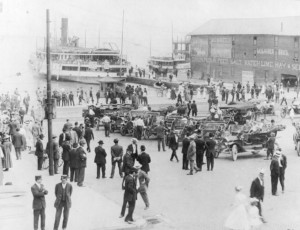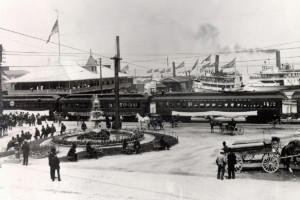
SCHADE-MYLANDER PLAZA
Foot of Columbus Ave (flag, trains), ca. 1900. Image courtesy of Sandusky Library Archives Research Center
The period from the Civil War through the 1920s was the golden age of lake steamers. Beautiful steamers like the R. B. Hayes, Jay Cooke, Put-in-Bay, City of Detroit, Chippewa, G. A. Boeckling, Arrow, Chief Justice Waite, and A. Wehrle, Jr. traveled western Lake Erie bringing tourists to Cedar Point, Sandusky, Lakeside, and South Bass and Kelleys islands. Listen to the boat whistles and the bells. Smell the coal or oil and see the smoke as the big engines got ready to work.
To both the left and right sides of the Columbus Avenue slip was dockage for passenger boats. Cedar Point had several boats running throughout the day back and forth from Sandusky to the Point. The island boats typically headed out mid-morning for the islands and made a return trip in the evening. Today, the story has not changed much. Though by automobile, tourists still arrive by the hundreds and take the boats to the Lake Erie Islands for a day’s outing.
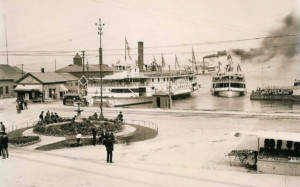
Standing at the foot of Columbus Avenue, the view is little changed in the last 100 years.
The plaza itself is reconstructed with a new fountain and reminiscent of the open plaza that existed here a century ago. In those earlier years the foot of Columbus Avenue was the transportation hub for tourists headed to the Lake Erie islands or Cedar Point. They came by train in the hundreds—and sometimes thousands—and were deposited at the foot of Columbus Avenue where they boarded a boat for their lake or bay journey.
Foot of Columbus Ave (Johnsons Is. Boat Landing), ca. 1890. Image courtesy of Sandusky Library Archives Research Center
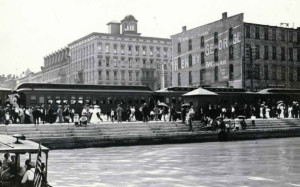
Foot of Columbus Ave (steps, train), ca. 1900. Image courtesy of Sandusky Library Archives Research Center
However, beyond the ferry boat activity today’s waterfront is vastly different from that of 1900. Today the waterfront is occupied by parks, marinas, and housing. One hundred years ago the waterfront was a cohesive group of interrelated businesses. Businesses engaged in fish, lumber, ice, and lime dotted the shore. For many years, Sandusky was the largest fresh water fishing port on the planet. The outlying area was surrounded by stands of hardwood forests ripe for harvest. There were huge quantities of quality limestone available. The lumber was harvested for building but also for construction of barrels to ship fish all over the country. Of course, to ship fish you needed ice. Ice was harvested out of Sandusky Bay in the winter and stored in ice houses that dotted the waterfront. To ship one pound of fish to the East Coast, 10 pounds of ice was needed, so demand for ice was strong. Sandusky had the largest capacity for ice storage west of the Hudson River. Area limestone was quarried for building, but also processed for making plaster and cement. This required cooking the limestone in furnaces fired by wood and then ground to a powder. The powder was then packaged in barrels for shipping. A cooper was a sought-after profession.

In this photo, there are horses all along Columbus Ave. The State Theater, as seen in the lower photo, will be built in 1928.
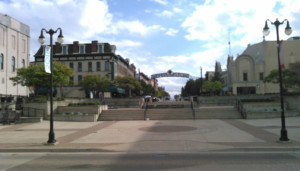
If you look to the left of the Schade-Mylander Plaza you see the Hubbard Building. The Hubbard Building is one of the earlier Sandusky buildings that has retained its original appearance. The property was purchased in 1854 by Lester Hubbard who constructed the limestone structure you see today. A variety of enterprises occupied the building through the years. About 25 years ago the building was acquired by Dan Delahunt who restored the building creating storefronts on the ground floor and condominiums in the upper floors.
To both the left and right sides of the Columbus Avenue slip was dockage for passenger boats. Cedar Point had several boats running throughout the day back and forth from Sandusky to the Point. The island boats typically headed out mid-morning for the islands and made a return trip in the evening. Today, the story has not changed much. Though by automobile, tourists still arrive by the hundreds and take the boats to the Lake Erie Islands for a day’s outing.
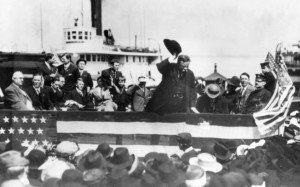

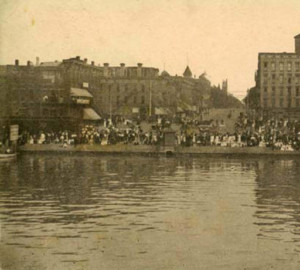
October 25, 1866 – The Time Has Come – Do Not Wait Any Longer – go to Henry Converse’s No. 3 Columbus Avenue and buy yourself the best pair of boots you ever had. Buy your wife a sweet hat and a pair of those splendid winter boots. Buy your daughter a pair of the new style of button boots. Buy your son a pair of those superior kit boots. Buy for all of your family, and all of your friends, for it is a settled fact that there you will find the best quality and the most fashionable goods, and lower prices than can be found in Sandusky. The fact is, it is the head-quarters for boots and shoes.
May 6, 1875 – Zinc water sets, slop jars and pails, tea trays and self-righting cuspidors at I D. Everett Son’s, 24 Columbus avenue.
January 16, 1968 – Laughing Gas – For painless extraction of teeth – Dr. D. F. Wemple, in announcing his return from New York, has the pleasure to inform his many patients and friends, that he has secured, direct from the inventor and patentees, apparatus combining the latest improvements for the production and use of pure Nitrous Oxide or ‘Laughing’ Gas, as administered by the Colton Dental Association of New York, where Dr. W. received the proper instructions in its use, and where 40,000 persons have testified to painless and pleasant experience. The patient awakens from a happy dream to find the cause of previous suffering removed. Price, $1 for the first tooth and 50 cents for each subsequent tooth. All dental operations performed with the greatest skill and care, at moderate prices. Beautiful SETS OF TEETH, inserted at as low price as can be obtained at any Dental Rooms in this city. Office and Residents, No. 49 Columbus Ave, three doors south of the Postoffice. D. F. Wemple, Dentist.

